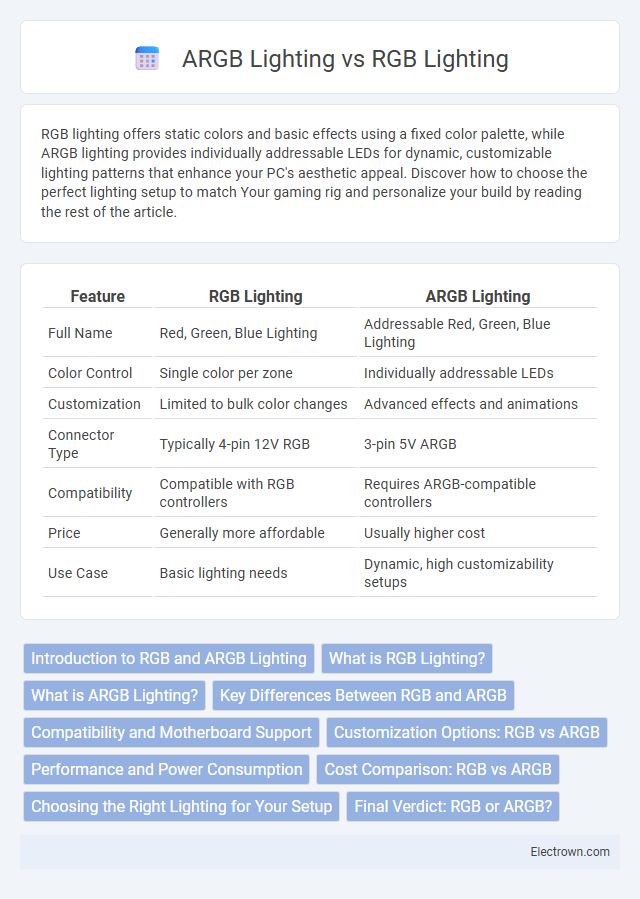RGB lighting offers static colors and basic effects using a fixed color palette, while ARGB lighting provides individually addressable LEDs for dynamic, customizable lighting patterns that enhance your PC's aesthetic appeal. Discover how to choose the perfect lighting setup to match Your gaming rig and personalize your build by reading the rest of the article.
Table of Comparison
| Feature | RGB Lighting | ARGB Lighting |
|---|---|---|
| Full Name | Red, Green, Blue Lighting | Addressable Red, Green, Blue Lighting |
| Color Control | Single color per zone | Individually addressable LEDs |
| Customization | Limited to bulk color changes | Advanced effects and animations |
| Connector Type | Typically 4-pin 12V RGB | 3-pin 5V ARGB |
| Compatibility | Compatible with RGB controllers | Requires ARGB-compatible controllers |
| Price | Generally more affordable | Usually higher cost |
| Use Case | Basic lighting needs | Dynamic, high customizability setups |
Introduction to RGB and ARGB Lighting
RGB lighting uses three primary colors--red, green, and blue--to create various static or dynamic lighting effects by mixing these colors. ARGB (Addressable RGB) lighting enhances this technology by allowing individual control of each LED, enabling complex animations and multi-color effects across a single strip. This distinction makes ARGB especially popular in customizable PC builds and gaming setups where intricate lighting patterns are desired.
What is RGB Lighting?
RGB lighting refers to a lighting system that combines Red, Green, and Blue LEDs to create a wide spectrum of colors by adjusting the intensity of each LED. This technology is commonly used in computer peripherals, gaming rigs, and ambient home lighting to enhance visual appeal with static or preset color effects. You can customize RGB lighting to display a single color or simple color-changing patterns based on predefined modes.
What is ARGB Lighting?
ARGB lighting, or Addressable RGB lighting, allows individual control of each LED within a strip, enabling dynamic and customizable lighting effects with a wider range of colors and patterns compared to standard RGB lighting. Unlike traditional RGB lighting, which changes all LEDs simultaneously to the same color, ARGB lighting offers synchronized animations, gradients, and complex visual effects through compatible controllers and software. Your PC build benefits from ARGB lighting by delivering personalized illumination that enhances both aesthetics and system ambiance with precision and versatility.
Key Differences Between RGB and ARGB
RGB lighting offers static or basic color-changing effects with all LEDs displaying the same color simultaneously, while ARGB (Addressable RGB) allows individual control of each LED for dynamic, complex lighting patterns and animations. ARGB provides enhanced customization options, enabling you to create personalized lighting effects by programming colors and transitions on a per-LED basis. Understanding the key differences helps you choose the best lighting system for your PC build, whether you prioritize simplicity or advanced visual flair.
Compatibility and Motherboard Support
RGB lighting uses a standard 4-pin connector that provides basic color options and is widely compatible with most motherboards supporting 12V RGB headers. ARGB lighting, featuring a 3-pin 5V connector, offers advanced individual LED control and requires a motherboard with an addressable RGB header for full customization. Your choice depends on whether your motherboard supports 12V RGB or 5V ARGB headers to ensure seamless integration and optimal lighting effects.
Customization Options: RGB vs ARGB
RGB lighting offers basic color customization with fixed colors or simple presets, allowing you to switch between solid colors but limiting flexibility. ARGB lighting provides advanced customization by enabling individual control over each LED, creating dynamic effects such as gradients, color waves, and reactive lighting patterns tailored to your preferences. Your choice between RGB and ARGB impacts the level of personalization achievable in your PC build or setup.
Performance and Power Consumption
RGB lighting typically consumes less power than ARGB lighting due to its simpler design with a single color per LED, resulting in more consistent performance with minimal energy usage. ARGB lighting offers customizable, multi-color effects at the cost of higher power consumption and slightly more complex circuitry, which may impact overall system efficiency. Choosing between RGB and ARGB lighting depends on your preference for dynamic visuals versus energy efficiency and system performance balance.
Cost Comparison: RGB vs ARGB
RGB lighting systems typically cost less than ARGB (Addressable RGB) solutions due to their simpler design and limited color control options. ARGB lighting offers individual LED customization with millions of colors and dynamic effects, which increases manufacturing complexity and price. For budget builds, basic RGB provides adequate aesthetics, while ARGB is favored for premium setups demanding advanced lighting customization.
Choosing the Right Lighting for Your Setup
RGB lighting provides a consistent color display across all LEDs, ideal for uniform illumination and simple aesthetic setups, while ARGB lighting offers individually addressable LEDs allowing for dynamic, customizable effects and complex animations suited to advanced configurations. When choosing the right lighting for your setup, consider ARGB's flexibility for synchronized system-wide patterns versus RGB's straightforward, cost-effective color consistency. Compatibility with your motherboard or controller and software support is critical, as ARGB requires specific headers and software for full control, whereas RGB operates on more universal standards.
Final Verdict: RGB or ARGB?
RGB lighting offers vibrant static colors with basic customization, making it ideal for users seeking simple, consistent illumination. ARGB lighting provides dynamic, individually addressable LEDs for intricate effects and personalized lighting patterns, enhancing your system's aesthetics with greater control. Your choice depends on whether you prioritize straightforward color options or advanced customization for a more immersive visual experience.
RGB Lighting vs ARGB Lighting Infographic

 electrown.com
electrown.com